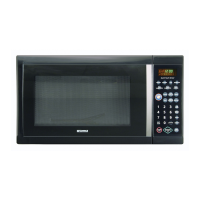Cooking Guide
MICROWAVE COOKING TIPS
Amount of food
• If you increase or decrease the amount of food
you prepare, thetime ittakes to cook that food will
also change. For example, ifyou double a recipe,
add a little more than half the original cooking time.
Check for doneness and, if necessary,add more
time in small increments.
Starting temperature of food
• The lower the temperature of the food being put
into the microwave oven, the longer it takes to cook.
Foodat roomtemperature will be re-heatedmore
quickly thanfood at refrigerator temperature.
Composition of food
• Food with a lot of fat and sugar will be heated
faster thanfood containing a lotof water. Fat and
sugar will also reacha higher temperaturethan
water inthe cooking process.
• The more dense the food, the longer it takes to
heat. "Very dense" food like meat takes longer to
reheat than lighter, more porousfood like sponge
cakes.
Size and shape
• Smaller pieces of food will cook faster than larger
pieces.Also, same shaped pieces cook more
evenly than different-shaped pieces.
• With foods that have different thicknesses, the
thinner parts willcook faster than the thicker parts.
Place the thinner parts of chicken wings and legs in
the center of the dish.
Stirring, turning foods
• Stirring and turning foods spreads heatquicklyto
the center of the dishand avoids overcooking at the
outer edges ofthe food.
Covering food
Cover food to:
• Reducesplattering
• Shorten cookingtimes
• Keep food moist
You can use any covering that lets microwaves pass
through. See "Getting to KnowYour Microwave
Oven"for materialsthat microwaveswill pass
through. Ifyou are using the Sensor function, be sure
to vent.
Releasing pressure in foods
• Several foods (for example: baked potatoes,
sausages, egg yolks, and some fruits) are tightly
covered by a skin or membrane. Steam can build up
under the membrane during cooking, causing the
food to burst.To relievethe pressure and to prevent
bursting, pierce these foods before cookingwith a
fork,cocktail pick, or toothpick.
Using standing time
• Always allow food to stand after cooking.
Standing time after defrosting and cooking allows
the temperature toevenly spreadthroughout the
food, improving the cooking results.
• The length of the standing time depends on how
much food you are cooking and how dense itis.
Sometimes it can be as short as the time it takes
you to remove the foodfrom the oven and take it to
the serving table. However, with larger, denser food,
the standing time may be as long as 10 minutes.
Arranging food
For best results, placefood evenly on the plate. You
can do this in several ways:
• If you are cooking several items of the same
food, such as baked potatoes, place them ina ring
pattern for uniform cooking.
• When cooking foods of uneven shapes or
thickness, such as chicken breasts, place the
smaller or thinner area of the food towardsthe
center of the dishwhere it will be heated last.
• Layer thin slices of meat on top of each other.
• When you cook or reheat whole fish, score the
skin - this prevents cracking.
• Do not let food or a container touch thetop or sides
of the oven. This will prevent possible arcing.
Using aluminum foil
Metal containers should notbe used in a microwave
oven. There are, however, some exceptions. If you
have purchased food which is prepackaged in an
aluminum foil container,refer tothe instructions on
the package.When using aluminum foil containers,
cooking times may be longer because microwaves
will only penetrate the top of thefood. If you use
aluminum containerswithout package instructions,
follow these guidelines:
26

